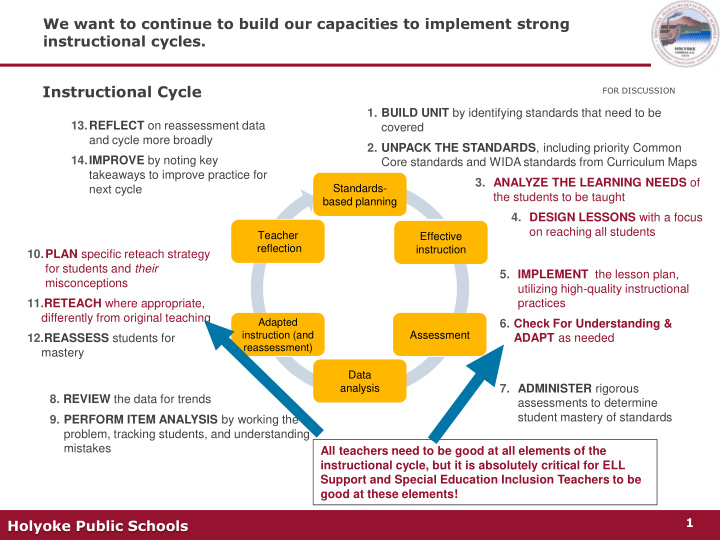



We want to continue to build our capacities to implement strong instructional cycles. Instructional Cycle FOR DISCUSSION 1. BUILD UNIT by identifying standards that need to be 13.REFLECT on reassessment data covered and cycle more broadly 2. UNPACK THE STANDARDS , including priority Common 14.IMPROVE by noting key Core standards and WIDA standards from Curriculum Maps takeaways to improve practice for 3. ANALYZE THE LEARNING NEEDS of Standards- next cycle Standards- the students to be taught based planning based planning 4. DESIGN LESSONS with a focus on reaching all students Teacher Teacher Effective Effective reflection instruction reflection instruction 10.PLAN specific reteach strategy for students and their 5. IMPLEMENT the lesson plan, misconceptions utilizing high-quality instructional 11.RETEACH where appropriate, practices differently from original teaching Adapted 6. Check For Understanding & Adapted instruction (and instruction (and Assessment Assessment ADAPT as needed 12.REASSESS students for reassessment) reassessment) mastery Data Data analysis analysis 7. ADMINISTER rigorous 8. REVIEW the data for trends assessments to determine student mastery of standards 9. PERFORM ITEM ANALYSIS by working the problem, tracking students, and understanding mistakes All teachers need to be good at all elements of the instructional cycle, but it is absolutely critical for ELL Support and Special Education Inclusion Teachers to be good at these elements! 1 Holyoke Public Schools
We need a shared understanding of the purpose of ELL and Special Education Services. The way we know our students have accessed meaningful educational opportunities is when they master core academic standards , as measured by achieving proficiency on state assessments. Proficiency The point of providing ELL and Special Education services is to ensure equal access to Mastering core meaningful educational academic opportunities for all So the most critical purpose of students. standards ELL and Special Education teachers is to provide ELLs and Students With Disabilities (SWDs) the Equal access instruction and services/supports they need to become proficient readers (or make progress toward proficiency). 2 Holyoke Public Schools
Too much of our current thinking about ELL supports and Special Ed inclusion is focused more on adult inputs than student outcomes. The logic of an input-based approach Identify approaches and Teacher set programs to be basically a static Everyone hopes used with schedule and that student students (e.g., provide services outcomes push-in/pull-out, according to a improve. Lindamood Bell, schedule. Word Generation, etc.) 3 Holyoke Public Schools
We need to move to an approach where teachers plan and adapt flexibly based on a relentless focus on student outcomes. The logic of an outcomes-based approach FOR DISCUSSION The ELL or inclusion teacher: Constantly tracks each • student’s assessment results Use data frequently Identifies which students • to monitor student are/aren’t making progress progress Identifies needed changes in • instruction of students not making progress The ELL or inclusion teacher: • Proactively engages the The ELL or inclusion teacher: classroom teachers to make sure students in their • Provides direct services caseloads get what they need targeted to address each Student during regular instruction student’s needs based on Outcomes (i.e., the “whatever it takes” analysis of assessment approach” results Proactively work with classroom Provide targeted teachers to meet student support student needs 4 Holyoke Public Schools
The caseload model is a specific way of implementing an outcomes approach to ELL and Inclusion instruction. Features of the Deliver effective and efficient Specialized Services caseload approach Know their • Manageable workload caseload • Targeted services to Share strategies & address disability related Strong sense practices needs of needed to • Monitored progress responsibility differentiate and urgency and scaffold instruction Features Case Manager Responsibilities Service Models • Attend all Team meetings • Consult Know the Track • Push-in • Ensure progress reports are curriculum assessment scope and completed, printed and provided results • Pull-out sequence to the team leader, and home • Co-teach room teacher of each student no later than the day report cards Use all • Carry over into regular are sent home to parents. available education and home resources • Provide summaries of the needs of the students on their caseload to general education teachers Among others… 5 Holyoke Public Schools
ELL and Inclusion teachers need tools in order to implement a caseload approach. Sample student progress tracker Holyoke Public Schools Caseload Teacher — Student Progress Tracker Teacher: School: Teacher Type (ELL or Special Ed): Grade Levels supported: Based on data, is the student making significant progress toward proficiency in ELA and Math (Y/N)? IEP? ELL Student And how am I supporting this student to progress toward proficiency? (Y/N) Level September – December January – March April - June A big emphasis on looking at student work! 6 Holyoke Public Schools
While there are many similarities between Special Education teachers and ESL teachers, there are some distinctions. Special Education Teacher English as a Second Language Expectations: Teacher Expectations: Clear and specific specialist schedules Clear and specific data reflecting student performance Examples of completed and corrected student work given by specialist Specialist ‘grade book’ Progress reports that reflect student performance data Clear and specific paraprofessional Clear and specific plans to binders address each domain of Clear and specific IEP goals and language learning objectives 7 Holyoke Public Schools
Recommend
More recommend